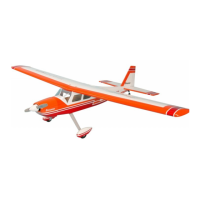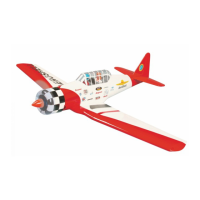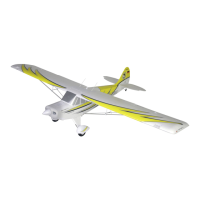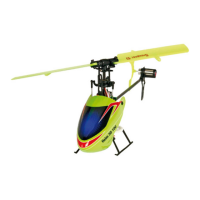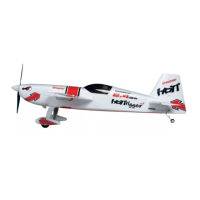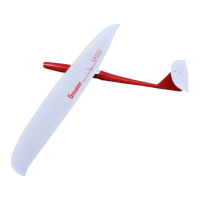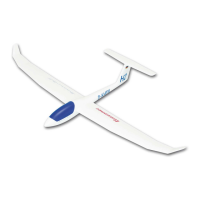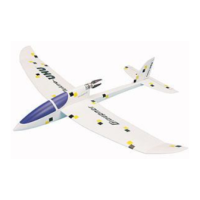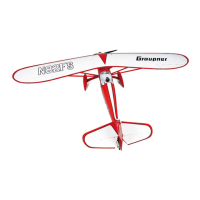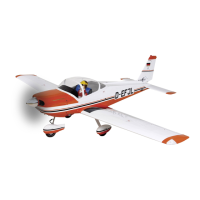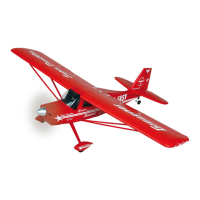GRAUPNER GmbH & Co. KG D-73230 KIRCHHEIM/TECK GERMANY
Änderungen vorbehalten! Keine Haftung für Druckfehler! Ident-Nr. 0057999
Made in Thailand
04/2003
67
67
Fueltank
− The model can accommodate fueltank bottles with a maximum diameter of 110 mm.
− The bottles we use are Pepsi disposable drinks bottles of 2 litres capacity.
− Cut three pieces 330 mm long from the 5 mm Ø CFRP rod (No. 67) and tape them in the arrangement
shown in (Fig. 19). It must be possible to push the fueltank bottle into the machined holders in the fuselage,
so that it is held firmly in position.
− Complete the fueltank as described in the turbine system instructions.
− Once the fueltank has been installed permanently, secure the throat of the bottle to the two
longitudinal plywood members in the fuselage using cable ties (No. 34a).
Turbine installation
− To install a JetCat turbine you will require a mounting clamp, Order No. 6800.9.
− Fix your turbine in the mounting clamp.
− Position the turbine as follows:
− The thrust nozzle (conical part) of the turbine must project into the thrust vectoring pipe by 5 mm (Fig. 20).
Check the position of the turbine by sighting through the opening in the thrust vectoring pipe; adjust the
position carefully until it is centred precisely (Fig. 20b).
Check that the turbine is lined up accurately with the thrust vectoring pipe. Check by eye that the turbine
cone is symmetrically positioned relative to the opening of the thrust vectoring pipe (Fig. 20b).
− Now fix the turbine in its correct position using the self-tapping screws (No. 50); even better: use the M3
socket-head cap screws, M3 captive nuts and washers (No. 64, 66, 68). The method of fixing the captive
nuts should be familiar by now!
Turbine electronics
− The turbine electronics plate (No. 25) is mounted on the longerons inside the fuselage: engage the
electronics plate in the hook-shaped machined recesses in the longitudinal formers (Fig. 21), and fix them
to the longitudinal formers at the front using two 2.9 Ø x 9.5 mm self-tapping screws (No. 50) (Fig. 21a).
Important: be sure to drill pilot-holes (max. 1.5 mm Ø) beforehand, to avoid splitting the material of the
longitudinal formers.
− Wire up the turbine electronics as described in the turbine instructions, and fix the components to the
machined plywood plate (No. 25) using cable ties (No. 34, 34a), or your own preferred method as shown in
(Fig. 21b). Group the cables together using soft binding wire (No. 72).
− Attach the turbine battery to the longitudinal former using cable ties (No. 34a) and double-sided tape (not
included in the kit), directly aft of the retract bulkhead. The arrangement can be seen in (Fig. 21c).
Radio control system components
− Note that the two rudder servos and the steerable nosewheel are controlled by the same receiver
channel - a good method of electronically coupling the servos is to use the Magic-Box, Order No.
3156, which is simply wired into the cable loom. This unit also allows you to reverse one or more
servos as required.
− Deploy all servo extension leads carefully and neatly, and group them together where possible using
retaining plates (No. 33), cable ties (No. 34) and binding wire (No. 71).
− The retaining plates (No. 33) are self-adhesive, but the joint should be reinforced with cyano for extra
security.
− Check that all plug / socket connections are sound, and tape them together to avoid any chance of vibration
shaking them loose.
− In the rear part of the model arrange the cables in such a way that there is absolutely no chance that
they could touch any part of the undercarriage, especially when the wheels are retracted. They
should also be kept as far from the turbine as possible to avoid possible heat damage and ingestion
into the engine. We strongly recommend that you fit a JetNet intake guard, Order No. 6800.21, to the
turbine.
− Adjust the position of the receiver battery and turbine battery until the model balances at the correct Centre
of Gravity without using lead ballast at nose or tail (Fig. 22).
− Centre of Gravity (CG): 95 - 100 mm forward of the front face of the wing joiner tube, measured at
the root rib.
− We recommend that you fit out and assemble the model completely, ready to fly
, before you install
the receiver and receiver battery in the model, so that you can position these parts in the optimum
location and obtain the correct CG without resorting to ballast.
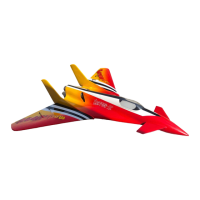
